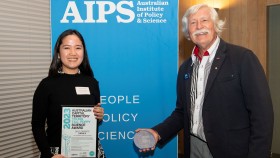Freeing carbon dioxide traffic jams key to plant yields
Researchers have discovered that the traffic flow of carbon dioxide during photosynthesis is affected by changes in temperature and that this response differs greatly between crops, a finding that could help improve crop production in a changing climate.
“We have just begun to understand the importance of the remarkable speedy journey in which CO2 molecules move back and forth through the middle of the leaf,” said lead researcher Professor Susanne von Caemmerer from The Australian National University (ANU).
“Our results shed light on how this trip is regulated, in other words, on the nature of the toll booths that CO2 finds in its way,” said lead researcher Professor von Caemmerer, a researcher in the ARC Centre of Excellence for Translational Photosynthesis (CoETP).
“This information will be crucial for us to predict the effect of rapid environmental changes on global food productivity.” Professor von Caemmerer and her colleagues aim to maximise yields of crops such as rice, wheat, soybean and cotton by improving photosynthesis, the process by which plants are built from sunlight, carbon dioxide and water. Co-researcher Professor John Evans, from the Research School of Biology and the CoETP, said they found a third limit that hadn’t been taken into account before.
“We previously thought photosynthesis was limited by two main factors: carbon dioxide crossing from the atmosphere through the external pores of the plant leaves, and the chemical reactions of key enzymes inside the leaf,” he said. “However, we now know a third limit is the ease of the flow of carbon dioxide’s long trip to get through the space in the middle of the leaf to the chloroplasts, where photosynthesis takes place. This speed, called mesophyll conductance, happens through a distance that, for an object the size of a carbon dioxide molecule, it’s like travelling from Canberra to Batemans Bay. But it has no vehicle – it only diffuses, just as perfume does, from high to low concentrations.”
By comparing different species including rice, tobacco, cotton, soybean, wheat, and brush box eucalyptus, the researchers found that that as temperature increased mesophyll conductance increased greatly in some species, and did not change at all in other species.
“These results are quite exciting because they have opened a whole set of new questions about how intracellular travel works. The answers to these questions are crucial if we want to be able to maximise crop yields,” said Professor von Caemmerer. The study was published recently on the journal Plant, Cell and Environment.
This project is part of the ARC Centre of Excellence for Translational Photosynthesis, the main node of which is located in the Research School of Biology at The Australian National University.








